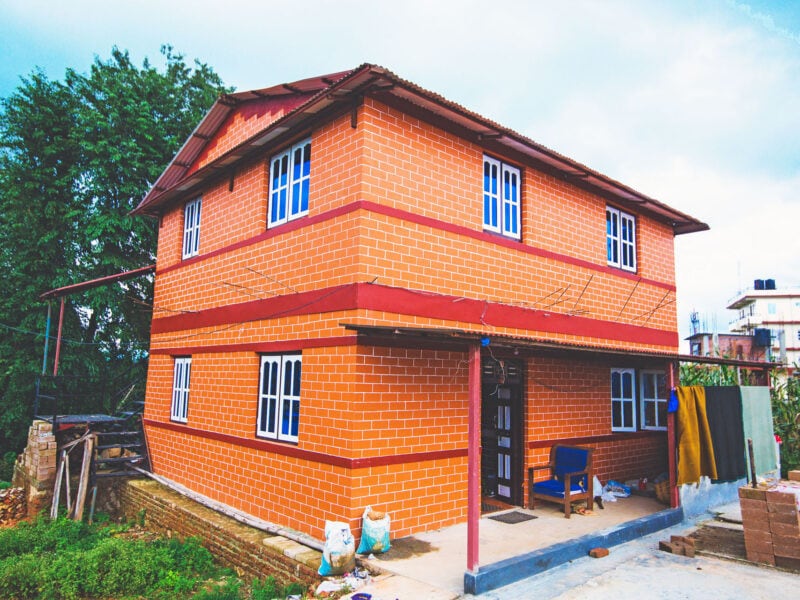Bjorn Soderberg has lived in Nepal for the past 25 years and was there when a magnitude 7.8 earthquake struck near Kathmandu in April 2015, killing nearly 9,000 people and destroying about 800,000 homes.
“At that point, me and my wife, we went out to the villages to try to help rebuild — and we realized that the problem here is vast because poor families can’t really afford earthquake-resistant houses,” Soderberg said.
In Nepal and Asia as a whole, coal-fired bricks are the primary construction material. The catch is that these bricks, as Soderberg put it, are “an absolute disaster for the climate.”
Soderberg said one-third of Nepal’s total carbon dioxide emissions come from the brick industry. On top of that, the industry relies on about 28,000 child laborers.
“These poor families, most of them can’t afford it. So either they’re going to build with these bricks that is a danger to the climate, or they’re going to build houses that are going to fall down in the next earthquake,” Soderberg said.
So, he set out to do something about it and co-founded Build up Nepal, a Kathmandu-based nonprofit organization that replaces coal-fired bricks with eco-friendly ones to make safe housing affordable for poor communities. Soderberg explained that the unique interlocking, stabilized-earth bricks can be made using locally available materials, with minimal cement, and are compressed instead of fired.
“We take soil and sand, both available locally in any village or town, and you mix it in with a little bit of cement and a little bit of industrial ash — mostly like rice, which has ash from rice mills — and compress it in a machine. So, it’s a cold process,” Soderberg said. “You still have some emissions from the cement, but if we’re looking at the total, it’s about 75% to 80% less than it is from the traditional bricks.”
Soderberg said the bricks essentially look and act like industrial Lego blocks that can be stacked together and reinforced, making them earthquake resilient while also reducing the need for mortar and cement when building a structure.
On Wednesday, Build up Nepal was chosen as the winner of the $250,000 Wilkes Climate Launch Prize for 2025. The prize is awarded by the University of Utah’s Wilkes Center for Climate Science and Policy.
The prize aims to accelerate worldwide progress and encourage technological advances to develop effective climate change solutions quickly, benefiting people and ecosystems worldwide, according to a statement from the university.
As a nonprofit, Build up Nepal doesn’t just produce bricks and sell them; instead, it partners with local entrepreneurs to empower communities to make the bricks themselves.
“To get this technology to every town, to every village across the whole country, how do we do that?” Soderberg asked. “We find locally, really driven entrepreneurs, and they set up a small business, (and) they buy a machine from us. We teach them how to make bricks and how to build disaster-resilient houses, and then they build their own communities. We are basically bringing in a technology, teaching them how to do it, but they are the ones building by themselves.”

This, Soderberg explained, is how the model becomes both affordable and sustainable. The impact extends far beyond simply constructing houses by creating jobs in low-income communities.
“It’s all about empowering them,” Soderberg said, adding that his organization has about 220 active enterprises producing the bricks in locations all across Nepal.
So far, 12,000 houses have been built with the bricks, reducing CO2 emissions by 111,000 tonnes and creating 1,600 environmentally friendly jobs in the process.
With that in mind, Soderberg said Build up Nepal has reached a pivotal point. In 2023, a magnitude 5.7 earthquake struck a remote part of northwestern Nepal, destroying another 8,000 homes.
“We had buildings right at the epicenter of this earthquake, and all our buildings were undamaged when most of everything else fell down. So that created very strong evidence for our technology,” Soderberg said. “This is our chance to make it big, because now we have the evidence. We have the trust, and what we need is to scale up fast enough to meet this demand that’s coming from the reconstruction.”
With that in mind, the nonprofit will use the $250,000 in prize money to set up as many local enterprises and train as many builders as it can.
“We have a chance to go international and everything. As we plan for the international expansion, having this prize with us, and showing that this has been kind of validated and vetted by Wilkes Climate Center, is going to help a lot,” Soderberg said.
He’s also hoping to see Build up Nepal’s model copied by others.
“What we are looking for is partners who basically want to pick up our model, pick up our technology, and do the same in their respective country. Because in this way, I believe that we can reach real scale,” Soderberg said.
“If we try to do it all ourselves, we’ll always be limited in how far we can reach,” he continued. “But if we try to do it together with others who are already embedded in their communities, in their respective countries, knowing their culture and knowing their situation, then I think we can do something big.”
